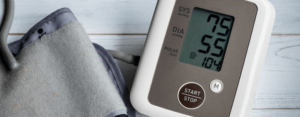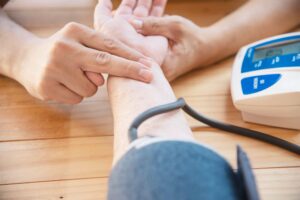Last updated on September 26th, 2024 at 11:15 am
Low blood pressure (hypotension) treatment involves various strategies aimed at raising and stabilizing blood pressure levels to alleviate symptoms. While it may not be as widely recognized as high blood pressure, low blood pressure can have a significant impact on an individual’s health and daily life.
Blood pressure is a measurement of the force exerted by blood against the walls of arteries as it flows through the circulatory system. It is typically expressed in two numbers: systolic pressure (the higher number) and diastolic pressure (the lower number).
Normal blood pressure is considered to be around 120/80 mm Hg, with variations being common among individuals. Hypotension is generally defined as a blood pressure reading consistently below 90/60 mm Hg. When blood pressure falls below these levels, it can lead to various symptoms and health complications, necessitating appropriate treatment.
Low Blood Pressure Diagnosis and Treatment
Low blood pressure diagnosis and treatment, or hypotension, is essential to alleviate symptoms and prevent potential complications. To diagnose the underlying cause, healthcare providers may perform blood pressure measurements in various positions (lying down, sitting, and standing) to identify conditions like orthostatic hypotension. Additionally, blood tests, electrocardiograms (ECG or EKG), and other diagnostic tools may be utilized to assess potential underlying medical conditions.

Low BP Treatment
Once the cause is determined, a tailored low BP treatment plan can be developed:
- Lifestyle Adjustments: For mild cases, lifestyle changes like increasing fluid and salt intake, wearing compression stockings, and adopting a regular exercise routine can help manage low blood pressure effectively.
- Dietary Modifications: A healthcare provider or dietitian may recommend dietary changes, including salt-rich foods, to raise blood pressure safely.
- Medications: In severe cases or when lifestyle modifications are insufficient, medications such as fludrocortisone, midodrine, or others may be prescribed to elevate blood pressure. Close monitoring by a healthcare provider is essential for these drugs as they may give rise to possible adverse reactions.
- Underlying Condition Management: If low blood pressure is a symptom of an underlying medical issue, like heart problems or endocrine disorders, addressing the primary condition is essential for effective treatment.
> Consult a doctor and Order Medicine Online
Low BP Treatment Food
Diet plays a pivotal role in low BP treatment or hypotension. Here are some essential dietary considerations:
- Salt: Increasing salt intake can be beneficial for individuals with low blood pressure, as salt helps the body retain fluids and raise blood pressure.
- Fluids: Staying well-hydrated is essential to prevent dehydration, a common cause of low blood pressure. Strive to maintain proper hydration by consistently consuming an appropriate quantity of water throughout the day. Herbal teas, fruit juices, and electrolyte-rich beverages can also contribute to fluid balance.
- Caffeine: Beverages like coffee and tea, which contain caffeine, can temporarily raise blood pressure. However, excessive caffeine consumption can lead to dehydration, so moderation is key.
- High-Sodium Foods: Incorporate foods naturally rich in sodium, such as pickles, olives, salted nuts, and certain canned soups, into your diet in moderation.
- Fruits and Vegetables: Consuming a diet rich in fruits and vegetables provides essential vitamins, minerals, and antioxidants that support overall cardiovascular health. Potassium-rich foods, like bananas and oranges, can help maintain healthy blood pressure levels.
- Small, Frequent Meals: Eating smaller, more frequent meals throughout the day can prevent sudden drops in blood pressure, particularly after large meals.
Read: What are Generic Medicines?
Low BP Treatment at Home
Low blood pressure, or hypotension, can often be effectively managed at home through simple yet impactful measures. Staying well-hydrated by drinking an adequate amount of water throughout the day is crucial, as dehydration can exacerbate low blood pressure.
Consuming smaller, more frequent meals can help stabilize blood pressure, preventing post-meal drops. Compression stockings can aid individuals prone to orthostatic hypotension, especially when rising from a sitting or lying position. Regular, gentle aerobic exercises such as walking and cycling can improve circulation, gradually raising blood pressure.
Avoiding triggers like excessive alcohol consumption and prolonged standing further supports home-based low-blood pressure management. Monitoring symptoms and seeking medical advice when needed ensures a proactive approach to your health.

Low BP Ayurvedic Treatment
Low BP Ayurvedic treatment involves holistic approaches to address hypotension, aiming to restore balance in the body. It often includes herbal remedies like ashwagandha and liquorice, which are believed to help regulate blood pressure. Dietary adjustments focus on warming foods and spices like ginger and black pepper to enhance circulation.
Yoga and pranayama (breathing exercises) aid in improving blood flow and energy balance. Lifestyle changes such as maintaining a consistent daily routine, proper sleep, and stress management through meditation contribute to managing low blood pressure. Ayurveda offers a comprehensive approach to promoting overall well-being and balancing blood pressure naturally.
Conclusion:
Low BP treatment encompasses a range of strategies, from lifestyle adjustments to medications, all aimed at improving an individual’s quality of life and alleviating the symptoms associated with hypotension. By working closely with healthcare providers and making informed choices, individuals with low blood pressure can effectively manage their condition and enjoy better health and well-being.
FAQs on Low BP Treatment
Q:1 What is low BP treatment?
Low blood pressure treatment involves lifestyle adjustments, dietary changes, and, in some cases, medications to raise and stabilize blood pressure levels, alleviating associated symptoms and improving overall well-being. Treatment is tailored to the individual’s specific condition and health needs.
Q:2 Can lifestyle changes alone effectively manage low blood pressure?
In many cases, yes. Simple lifestyle adjustments like increasing fluid and salt intake, wearing compression stockings, and staying hydrated can help manage mild to moderate low blood pressure.
Q:3 Are there specific foods that can help raise low blood pressure naturally?
Yes, certain foods like pickles, olives, salted nuts, and potassium-rich fruits such as bananas and oranges can be incorporated into the diet to help increase salt intake and support blood pressure regulation.
Q:4 Is medication always necessary for low blood pressure treatment?
No, medications are typically reserved for severe cases or when lifestyle changes alone are insufficient. Your healthcare provider will assess your condition and recommend treatment accordingly.
Related Links:
